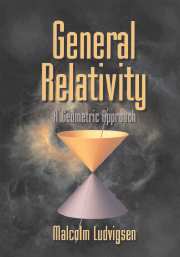Book contents
- Frontmatter
- Contents
- Preface
- PART ONE THE CONCEPT OF SPACETIME
- PART TWO FLAT SPACETIME AND SPECIAL RELATIVITY
- 3 Flat Spacetime
- 4 The Geometry of Flat Spacetime
- 5 Energy
- 6 Tensors
- 7 Tensor Fields
- 8 Field Equations
- PART THREE CURVED SPACETIME AND GRAVITY
- PART FOUR COSMOLOGY
- Solutions and Hints to Selected Exercises
- Bibliography
- Index
3 - Flat Spacetime
Published online by Cambridge University Press: 04 June 2010
- Frontmatter
- Contents
- Preface
- PART ONE THE CONCEPT OF SPACETIME
- PART TWO FLAT SPACETIME AND SPECIAL RELATIVITY
- 3 Flat Spacetime
- 4 The Geometry of Flat Spacetime
- 5 Energy
- 6 Tensors
- 7 Tensor Fields
- 8 Field Equations
- PART THREE CURVED SPACETIME AND GRAVITY
- PART FOUR COSMOLOGY
- Solutions and Hints to Selected Exercises
- Bibliography
- Index
Summary
Let us now restrict attention to a region of spacetime where gravitational tidal effects may be neglected. Such a region may extend for many lightyears in interstellar space or the confines of a freely falling spaceship over an interval of a few seconds near the surface of the earth. In this chapter we shall take this region to be effectively infinite, so it is perhaps better to imagine it lying in the depths of interstellar space, well away from any gravitational influences. We shall also restrict attention to inertial particles and inertial observers and represent their world lines by straight lines. The reason for this will soon be apparent.
Distance, Time, and Angle
Our intrepid observers, Peter, Paul, and their new friend Pauline, now find themselves in the pitch blackness of interstellar space, and in order to amuse themselves – and also to discover the secrets of spacetime – they communicate by means of light rays or, equivalently, photons. Let us say that Paul emits a photon, which is received by Peter. In general, the photon's frequency according to Paul will be different from that according to Peter. This is, of course, just the Doppler effect in operation. If, however, the transmitted and received frequencies are the same whenever the experiment is performed, then Peter will say that his friend Paul has zero relative speed. By repeating this procedure but in the reverse order, Paul will say that Peter has zero relative speed – if this were not the case, then the principle of relativity would be contradicted. If their relative speeds are zero in this sense, we say that their world lines are parallel.
- Type
- Chapter
- Information
- General RelativityA Geometric Approach, pp. 21 - 26Publisher: Cambridge University PressPrint publication year: 1999

